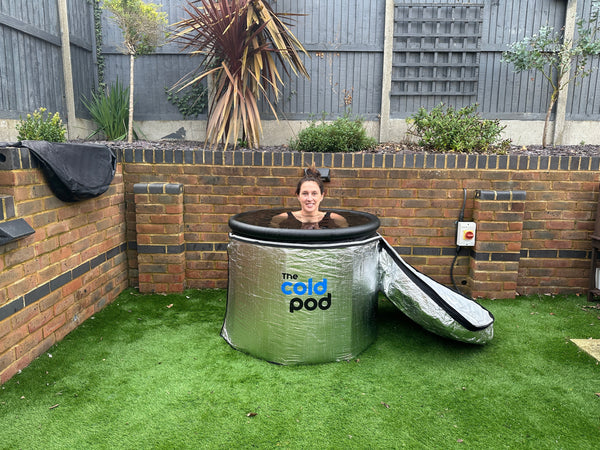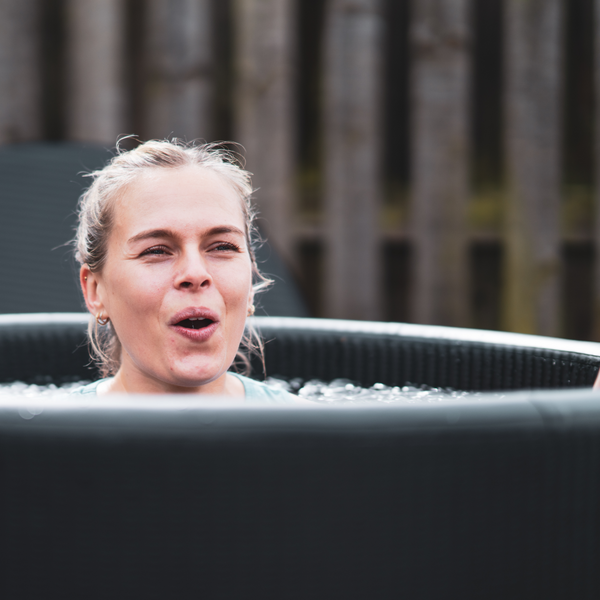Introduction
As winter’s chill settles in, many of us find ourselves instinctively seeking warmth and comfort. The idea of immersing oneself in icy water during this time might seem counterintuitive, if not downright daunting. However, there’s a growing trend that suggests otherwise – the practice of taking ice baths during the winter months. Contrary to what it may seem, plunging into freezing water can offer an array of health benefits. Including a boost to your immunity and resilience.
The concept of using extreme cold as a wellness tool has gained considerable attention in recent years. With enthusiasts and health practitioners alike extolling its virtues. This blog will explore the fascinating world of cold plunges in winter. Shedding light on the science behind this practice and the remarkable effects it can have on your body and mind.
From strengthening your immune system to enhancing mental and physical resilience, ice baths have emerged as a powerful tool for those seeking improved well-being in the colder months. We’ll delve into the science that underpins these benefits. Also, we’ll offer guidance on how to incorporate ice baths into your winter routine safely and effectively.
So, if you’re curious about the invigorating potential of winter cold plunges and how they can help you thrive during the season, read on. The icy waters might just hold the key to a healthier, more resilient you in the midst of winter’s embrace.
The Science Behind Ice Baths
Ice baths, also known as cold water immersion, may seem like an extreme practice. But there’s a scientific basis for their benefits. Understanding how the body reacts to cold exposure can help demystify the process. Additionally, it sheds light on why so many people swear by the advantages of taking cold dips, especially during the winter months.
How Cold Exposure Affects the Body
When you submerge your body in cold water, several physiological responses occur:
Vasoconstriction: The blood vessels in your skin constrict (narrow), reducing blood flow to the extremities and helping to conserve heat.
Shivering: In response to the cold, your muscles contract involuntarily, generating heat as a byproduct of this muscle activity.
Brown Fat Activation: Your body has two types of fat – white fat, which stores energy, and brown fat, which burns calories to generate heat. Cold exposure can stimulate the activation of brown fat, helping to keep you warm.
Activation of Brown Fat
Brown fat, also known as brown adipose tissue (BAT), is a type of fat that’s particularly rich in mitochondria, the energy-producing powerhouses of cells. Unlike white fat, which stores energy, brown fat is specialised for thermogenesis, the process of generating heat.
Cold exposure prompts the activation of brown fat. When you’re immersed in icy water, your body perceives this as a threat to your core temperature. To counteract the cold, brown fat cells release energy by burning stored fat and glucose, producing heat in the process. This mechanism helps to maintain your body temperature. And it is one of the reasons why ice baths are considered a potent tool for improving metabolism.
Release of Endorphins
The shock of cold water can stimulate the release of endorphins, which are natural painkillers and mood enhancers. This surge in endorphins is often associated with a feeling of euphoria and heightened alertness, known as the “cold water high.” It’s not uncommon for cold dipping enthusiasts to describe a sense of invigoration and mental clarity after their cold exposure sessions.
Influence on the Immune System
Emerging research suggests that cold exposure may have a positive impact on the immune system. Cold water immersion has been shown to:
Increase White Blood Cells: Cold exposure can lead to an increase in the production of white blood cells, which play a crucial role in the body’s immune response.
Enhance Lymphatic System Function: The lymphatic system is responsible for transporting immune cells throughout the body. Cold exposure may improve lymphatic circulation, helping immune cells reach their destinations more effectively.
Understanding these physiological responses to cold exposure can help you appreciate how cold dips can contribute to your overall well-being.
Boosting Immunity Through Ice Baths
During the winter season, maintaining a robust immune system becomes paramount. Ice baths might not be the first thing that comes to mind when considering immune-boosting practices. But the science suggests that this unconventional approach can have a profound impact on your body’s ability to ward off illnesses.
Strengthening the Immune Response
One of the most compelling reasons to consider cold plunges during winter is their potential to strengthen your immune response. Here’s how it works:
Increased White Blood Cell Production: Cold exposure has been linked to an increase in the production of white blood cells, which are the foot soldiers of your immune system. These cells play a pivotal role in identifying and neutralising pathogens, such as viruses and bacteria. By bolstering their numbers, your body becomes better equipped to mount a swift and effective immune response when exposed to potential threats.
Enhanced Lymphatic System Function: The lymphatic system, often referred to as the body’s “second circulatory system,” is responsible for transporting immune cells throughout the body. Cold exposure may improve the function of the lymphatic system, facilitating the movement of immune cells to where they are needed most. This enhanced circulation can help the immune system respond more efficiently to infections.
Reducing the Risk of Winter Illnesses
Cold and flu season can be a challenging time for many, with respiratory infections and viral illnesses on the rise. Ice baths may offer some protection by:
Cold and Flu Prevention: Regular cold exposure has been associated with a reduced susceptibility to common winter illnesses like the cold and flu. A stronger immune system, as well as the improved circulation and heat generated during cold exposure, can create a less hospitable environment for pathogens.
Improved Respiratory Health: Cold water immersion can also have a positive impact on respiratory health. It’s not uncommon for cold bath enthusiasts to report better lung function and an increased ability to breathe deeply. This may be particularly beneficial during the winter when respiratory infections are prevalent.
While ice baths aren’t a guaranteed shield against all winter illnesses, they can certainly contribute to your overall resilience. By empowering your immune system to better defend against external threats. When combined with other healthy practices such as proper nutrition and good hygiene, ice baths can be a valuable tool in your winter wellness arsenal.
In the next section, we’ll explore how ice baths can go beyond immunity to enhance your mental and physical resilience, helping you navigate the challenges of winter with greater ease and vigour.
Building Resilience with Ice Baths
Beyond the immune-boosting effects, cold dips offer a range of benefits that can help enhance both your mental and physical resilience during the winter months. Let’s explore how the practice of immersing yourself in icy water can contribute to your overall resilience.
Improved Mental Resilience
Stress Reduction and Enhanced Mood: Taking an ice bath can be an intense experience that forces you to focus on the present moment. The shock of cold water triggers the release of endorphins, which are natural mood elevators and stress relievers. Over time, this can lead to improved mental resilience as you learn to manage stress more effectively.
Mental Clarity and Focus: Many individuals who regularly engage in cold exposure report an increased sense of mental clarity and heightened focus. This mental acuity can be particularly valuable during the winter. When shorter days and colder temperatures can sometimes dampen your spirits and concentration.
Physical Resilience
Increased Pain Tolerance: Exposure to cold water can raise your pain threshold, making it easier to endure discomfort or pain. This can be a valuable skill, especially if you’re an athlete or engage in physical activities during the winter months.
Reduced Inflammation: Cold water immersion has been associated with a decrease in inflammation, which is the body’s natural response to injury or stress. By reducing inflammation, cold dipping may help you recover faster from physical strain and injuries, allowing you to maintain your active lifestyle even in the colder season.
Benefits for Athletes and Fitness Enthusiasts
Ice baths have long been a popular recovery tool among athletes. Here’s how they can benefit those who are physically active during the winter:
Faster Recovery: Cold water immersion can aid in the recovery process by reducing muscle soreness and inflammation. This means you can bounce back more quickly after intense workouts or sporting events.
Improved Performance: Some athletes use ice baths as part of their training regimen to increase endurance and improve their performance. Cold exposure can enhance the body’s ability to adapt to stress and recover faster between workouts.
Whether you’re facing the winter blues or gearing up for physical challenges in the cold, incorporating cold plunges into your routine can help you build resilience, both mentally and physically. As you learn to embrace discomfort and overcome it, you’ll discover a newfound sense of strength that extends beyond the ice bath itself.
Safe Practices for Ice Baths
Cold dips can offer numerous benefits for immunity and resilience. However, it’s essential to approach them with caution and follow safe practices to ensure a positive experience. Here are some guidelines to help you make the most of your ice bath sessions while minimising risks:
Gradual Acclimatisation
Start Slowly: If you’re new to cold dipping, begin with shorter exposure times and slightly warmer water temperatures. Gradually increase the duration and decrease the water temperature as you become more accustomed to the cold.
Listen to Your Body: Pay close attention to how your body responds. If you experience excessive shivering, intense discomfort, or numbness, it’s essential to exit the ice bath immediately.
Proper Clothing and Gear
Wear Appropriate Attire: When cold plunging, wear minimal clothing to ensure that your skin is in direct contact with the cold water. A swimsuit or lightweight clothing is often suitable.
Protect Extremities: Consider wearing neoprene booties or gloves to protect your hands and feet from extreme cold.
Monitoring for Signs of Hypothermia
Know the Symptoms: Educate yourself about the signs of hypothermia, which can include intense shivering, confusion, slurred speech, and a rapid heart rate. If you or anyone participating in cold dipping experiences these symptoms, seek medical attention immediately.
Consultation with a Healthcare Professional
Check with Your Doctor: Before incorporating ice baths into your routine, especially if you have any underlying medical conditions or concerns, consult with a healthcare professional. They can provide guidance tailored to your specific health needs.
Buddy System
Never Cold Plunge Alone: It’s advisable to have someone present when you’re taking an ice bath. Particularly if you’re new to the practice. They can assist you in case of an emergency and ensure your safety throughout the session.
Proper Hydration and Nutrition
Stay Hydrated: Drink plenty of fluids before and after an icy dip to stay hydrated. Cold exposure can cause increased fluid loss through sweating and may lead to dehydration if not adequately addressed.
Post-Ice Bath Nutrition: After a cold plunge, consider consuming a warm, meal or beverage to help your body recover and replenish energy.
By following these safety guidelines, you can enjoy the benefits of ice baths. Whilst also minimising the risks associated with cold exposure. Remember that safety should always be a top priority, and it’s essential to respect your body’s limits. As you gain experience and confidence, you can gradually push your boundaries, but never at the expense of your well-being.
In the next section, we’ll discuss practical ways to incorporate cold plunges into your winter routine. Making them an accessible and enjoyable part of your wellness regimen.
Incorporating Ice Baths into Your Winter Routine
Now that you’ve learned about the science behind ice baths and the importance of safe practices, let’s explore how you can seamlessly integrate icy dips into your winter routine. Whether you’re a curious beginner or an experienced enthusiast, there are various approaches to consider.
Setting up an Ice Bath at Home
If you prefer the convenience and privacy of your home, setting up an ice bath is a viable option:
Choose a Suitable Container: Opt for a large enough container or bathtub to accommodate your body comfortably. Make sure it’s deep enough to submerge yourself in water up to your chest.
Temperature Control: Invest in a reliable thermometer to monitor water temperature. Start with slightly cold water, around 10-15 degrees Celsius (50-59 degrees Fahrenheit), and gradually decrease it over time.
Ice or Cold Water: You can use ice cubes to cool the water. Or fill the container with cold water from the tap. Adjust the amount of ice or cold water to achieve your desired temperature.
Timing: Begin with short sessions, around 1-3 minutes, and increase the duration as you become more accustomed to the cold. Some enthusiasts eventually work up to 10-20 minute sessions.
Visiting Cold Water Therapy Centres or Spas
For a more controlled and immersive experience, consider visiting cold water therapy centers or spas:
Professional Supervision: These facilities often have experienced staff who can guide you through your ice bath session, ensuring your safety and comfort.
Variety of Options: Cold water therapy centres may offer various cold immersion experiences. Including cold plunge pools, cold water baths, or cryotherapy chambers. Allowing you to choose what suits you best.
Combining Ice Baths with Other Wellness Practices
Ice baths can be seamlessly integrated into your existing wellness routine:
Mindfulness and Breathing: Practising deep breathing and mindfulness techniques during an icy dip can help you stay calm and focused. Hence enhancing the mental benefits of the experience.
Post-Ice Bath Rituals: After your cold dip, consider practices like stretching, yoga, or meditation to enhance relaxation and recovery.
Regular Schedule: Incorporate ice baths into your weekly or monthly routine to maximise their benefits. Consistency is key when it comes to adapting to cold exposure.
Examples of Ice Bath Routines
Here’s a sample cold exposure routine to get you started:
Preparation: Gather all necessary equipment, fill your container with cold water, and ensure your environment is warm and comfortable.
Warm-Up: Engage in light physical activity or stretches to increase your body temperature before the ice bath.
Immerse Slowly: Enter the ice bath gradually, starting with your feet and working your way up to your neck. Focus on controlled breathing.
Duration: Begin with a short duration, such as 1-3 minutes, and gradually increase it over time as your tolerance improves.
Exit Calmly: When you’re ready to exit, do so slowly and mindfully. Wrap yourself in warm towels or blankets to warm up quickly.
Recovery: After the ice bath, engage in gentle exercises or relaxation techniques to aid recovery.
Remember that each person’s tolerance to cold varies, so listen to your body and adjust your routine accordingly. The goal is to make cold dipping a manageable and enjoyable part of your winter wellness regimen. Helping you to boost your immunity and resilience in the cold season.
Conclusion
As winter wraps its icy embrace around us, the concept of immersing oneself in cold water may seem unconventional. However, the practice of ice baths holds a unique allure, one that promises to invigorate the body. But also, to strengthen our immunity and resilience during the coldest months of the year.
In conclusion, ice baths in winter offer a unique and invigorating path to boost your immunity and resilience. They are a reminder that sometimes, the most extraordinary benefits can be found in the most unexpected places. As you embark on your own ice bath journey, remember that the icy waters hold the potential not only to strengthen your body. But also to transform your relationship with the season, allowing you to thrive in the heart of winter.
So, as the temperature drops and the days grow shorter, consider taking that icy plunge. Your body, mind, and spirit might just thank you for it.
In the spirit of resilience and wellness, embrace the cold. May your winter be one of strength, vitality, and a renewed sense of vitality.







